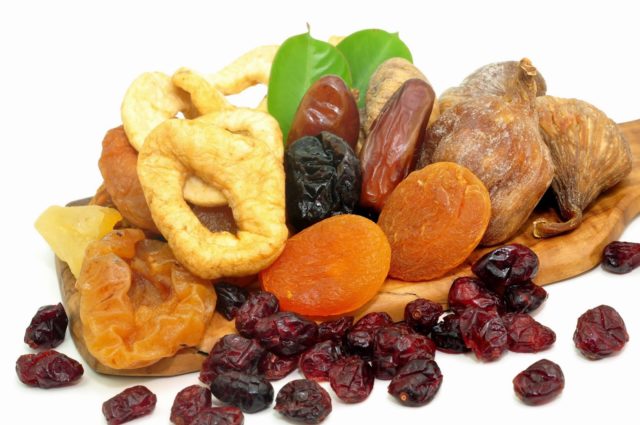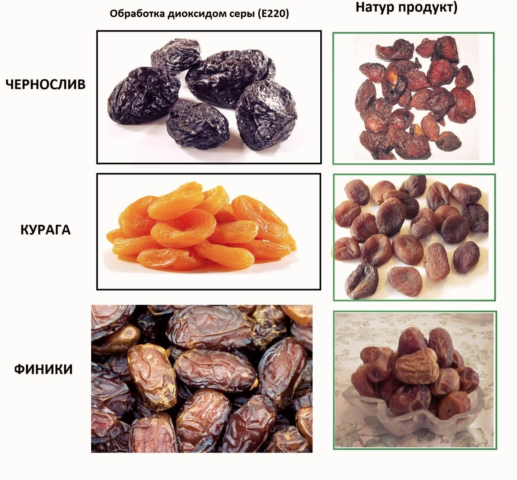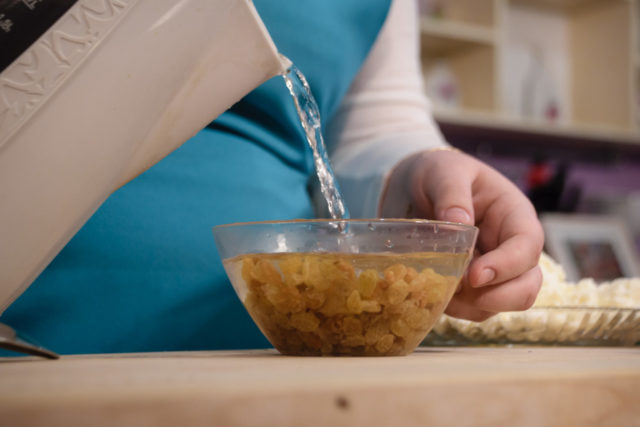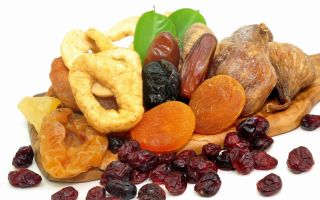Content
The preservative E220 in dried fruits is used as a means that improves the appearance of these products and prolongs their shelf life. It protects against decay and premature browning. But the E220 additive is toxic and can cause severe allergic reactions.
What is E220 in dried fruits
E220 preservative is sulfur dioxide, a colorless gas with a pungent smell of hydrogen sulfide. The additive is used in the food industry. At the production site, E220 is obtained by roasting sulfide ores. Chemical formula of the preservative SO2. It is a combination of sulfur and oxygen.
When frozen to - 10 ° C, the gas turns into a liquid state. Sulfur dioxide solution is used to treat food products in order to increase their shelf life. The method of fumigation with gas is also used.
Sulfur dioxide is a synthetic antioxidant. It interacts with active radicals, converting them into inactive ones, and suppresses oxidation reactions.
Why is the processing of dried fruits with sulfur dioxide done?
The additive has an antimicrobial effect and helps to keep the fruit fresh. E220 is used to prevent the reproduction of pests, the preservative kills microorganisms. But its use makes dried fruits not useful, as is commonly believed, but a harmful product.
Dried fruits are treated with sulfur dioxide to prevent the growth and reproduction of fungi and bacteria, to prevent the appearance of mold. When processing fruits with sulfur dioxide, the process of their enzymatic darkening and the formation of melanoidins is suspended.
E220 is necessary to give a marketable appearance to dried fruits. If there are red-burgundy cherries, bright orange dried apricots, blue-black prunes on the counter, it means that they have been treated with sulfur dioxide.

Why is the preservative E220 in dried fruits dangerous?
SO2 gas, which is used to treat dried fruits and berries from spoilage and pests, is toxic. He was assigned a medium hazard class. This means that when ingested in acceptable amounts, sulfur dioxide is relatively harmless.
But doctors advise to completely abandon the use of foods that are processed with E220, or to take measures to eliminate SO2 before eating them. This preservative has a destructive effect on vitamins B1, H and destroys B12. The researchers note that E220 negatively affects the work of the body's defenses.
The most dangerous preservative for people suffering from allergies and asthma. But for the majority, the additive is harmless, provided that the permissible concentration is not exceeded when processing products. The maximum allowed amount is 100 mg per 1 kg of dried fruit.
The likelihood of developing complications with the use of fruits with E220 is higher in young children, pregnant women and the elderly.Their body should receive no more than 0.7 mg of a substance per 1 kg of weight. But for some, even consuming an acceptable amount of SO2 can lead to problems.
According to the WHO, more than 65% of children with bronchial asthma are sensitive to E220. This supplement is one of the ten most dangerous allergens. In Russia and other post-Soviet countries, the preservative is allowed for use in the food industry, but in Australia, the USA, and New Zealand it is not used.
The effect of sulfur dioxide in dried fruits on the body
E220 preservative is considered dangerous. But its influence on a person depends on individual susceptibility. When it enters the body, sulfur dioxide is oxidized by special enzymes to sulfate and excreted in the urine. But not all people have these enzymes in the required amount. The degree of sensitivity to the additive also depends on the acidity of the gastric juice. With its increase or decrease, the tolerance of the preservative deteriorates.

Sensitive people may experience health problems when consuming sulfur dioxide products. Harm from the preservative E220 in dried fruits:
- headaches;
- dry mouth;
- cough;
- a sore throat;
- rhinitis, nasal congestion;
- digestive disorders, manifested by diarrhea;
- vomiting;
- nausea.
In people with bronchial asthma, after ingestion of sulfur dioxide, an attack of suffocation may begin, some develop pulmonary edema or uncontrollable vomiting opens. But such complications are typical for cases when concentrated SO2 gets on the mucous membranes. When eating dried fruits, the probability of these problems is minimal. Such complications are possible only with hypersensitivity to the preservative.
People with renal insufficiency should refuse dried fruits processed with E220. Sulfur dioxide is excreted through the kidneys, the main load is on them. When this preservative enters the body in large quantities, the kidneys may not be able to cope with its processing and elimination.
Some researchers believe that the systematic consumption of foods containing SO2 increases the risk of developing cancer.
How to remove sulfur dioxide from dried fruits
You can reduce the likelihood of developing complications when eating dried fruits if you figure out how to neutralize them with E220. This additive is highly soluble in water.
To remove E220 from dried fruits, you need to rinse them and soak them in clean water. The recommended temperature is 18-25 ° C. After 20-30 minutes, the water should be drained, the dried fruits should be rinsed again and filled with clean water for 20 minutes.
Allergy sufferers and people with asthma are advised to rinse them according to this scheme at least 3-4 times. The longer the dried fruits are soaked and the more intensively they are washed, the less preservative will remain.
It is undesirable to process dried fruits for more than 2 hours, otherwise they will get wet. If you soak them in hot water, then the glucose content in dried fruits will decrease. This is the reason for the deterioration of their taste.
You need to process all purchased dried fruits, regardless of the place of purchase. Dried fruits with E220 are sold in markets, supermarkets, company stores. They should be rinsed and soaked immediately before use.

Conclusion
The E220 preservative in dried fruits is harmless to people who are insensitive to it.But for allergy sufferers and asthmatics, this supplement can worsen the condition. It provokes the development of problems with the work of the respiratory and digestive organs. You can reduce the content of E220 if you rinse and soak the dried fruit well.

